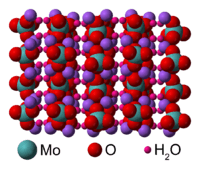Sodium molybdate
| | |
 | |
 | |
| Names | |
|---|---|
| IUPAC name
Sodium molybdate | |
| Other names
Disodium molybdate | |
| Identifiers | |
| 7631-95-0 10102-40-6 (dihydrate) | |
| 3D model (Jmol) | Interactive image |
| ChEBI | CHEBI:75215 |
| ChemSpider | 55350 |
| ECHA InfoCard | 100.028.683 |
| EC Number | 231-551-7 |
| PubChem | 61424 |
| RTECS number | QA5075000 |
| |
| |
| Properties | |
| Na2MoO4 | |
| Molar mass | 205.92 g/mol (anhydrous) 241.95 g/mol (dihydrate) |
| Appearance | White powder |
| Density | 3.78 g/cm3, solid |
| Melting point | 687 °C (1,269 °F; 960 K) |
| 84 g/100 ml (100 °C) | |
| Refractive index (nD) |
1.714 |
| Hazards | |
| Safety data sheet | External MSDS |
| NFPA 704 | |
| Flash point | Non-flammable |
| Lethal dose or concentration (LD, LC): | |
| LD50 (median dose) |
4000 mg/kg (rat, oral)[1] |
| LC50 (median concentration) |
>2080 mg/m3 (rat, 4 hr)[1] |
| Related compounds | |
| Other anions |
Sodium chromate Sodium tungstate |
| Other cations |
Ammonium molybdate |
| Except where otherwise noted, data are given for materials in their standard state (at 25 °C [77 °F], 100 kPa). | |
| | |
| Infobox references | |
Sodium molybdate, Na2MoO4, is useful as a source of molybdenum.[2] It is often found as the dihydrate, Na2MoO4·2H2O.
The molybdate(VI) anion is tetrahedral. Two sodium cations coordinate with every one anion.[3]
History
Sodium molybdate was first synthesized by the method of hydration.[4] A more convenient synthesis is done by dissolving MoO3 in sodium hydroxide at 50–70 °C and crystallizing the filtered product.[3] The anhydrous salt is prepared by heating to 100 °C.
- MoO3 + 2NaOH + H2O → Na2MoO4·2H2O
Uses
The agriculture industry uses 1 million pounds per year as a fertilizer. In particular, its use has been suggested for treatment of whiptail in broccoli and cauliflower in molybdenum-deficient soils.[5][6] However, care must be taken because at a level of 0.3 ppm sodium molybdate can cause copper deficiencies in animals, particularly cattle.[3]
It is used in industry for corrosion inhibition, as it is a non-oxidizing anodic inhibitor.[3] The addition of sodium molybdate significantly reduces the nitrite requirement of fluids inhibited with nitrite-amine, and improves the corrosion protection of carboxylate salt fluids.[7]
In industrial water treatment applications where galvanic corrosion is a potential due to bimetallic construction, the application of sodium molybdate is preferred over sodium nitrite. Sodium molybdate has the advantage in that the dosing of lower ppm's of molybdate allow for lower conductivity of the circulating water. Sodium molybdate at levels of 50-100 ppm offer the same levels of corrosion inhibition that sodium nitrite at levels of 800+ ppm. By utilizing lower concentrations of sodium molybdate, conductivity is kept at a minimum and thus galvanic corrosion potentials are decreased.[8]
Reactions
When reacted with sodium borohydride, molybdenum is reduced to a lower valent oxide:[9]
- Na2MoO4 + NaBH4 + 2H2O→ NaBO2 + MoO2 + 2NaOH+ 3 H2
Sodium molybdate reacts with the acids of dithiophosphates:[3]
- Na2MoO4 + (RO)2PS2H (R = Me, Et) → [MoO2(S2P(OR)2)2]
which further reacts to form [MoO3(S2P(OR)2)4].
Safety
Sodium molybdate is incompatible with alkali metals, most common metals and oxidizing agents. It will explode on contact with molten magnesium. It will violently react with interhalogens (e.g., bromine pentafluoride; chlorine trifluoride). Its reaction with hot sodium, potassium or lithium is incandescent.[10]
References
- 1 2 "Molybdenum (soluble compounds, as Mo)". Immediately Dangerous to Life and Health. National Institute for Occupational Safety and Health (NIOSH).
- ↑ Greenwood, Norman N.; Earnshaw, Alan (1984). Chemistry of the Elements. Oxford: Pergamon Press. ISBN 0-08-022057-6.
- 1 2 3 4 5 Braithwaite, E.R.; Haber, J. Molybdenum: An outline of its Chemistry and Uses. 1994. Elsevier Science B.V. Amsterdam, The Netherlands.
- ↑ Spitsyn, Vikt. I.; Kuleshov, I. M. Zhurnal Obshchei Khimii 1951. 21. 1701-15.
- ↑ Plant, W. (1950). "Use of Lime and Sodium Molybdate for the Control of 'Whiptail' in Broccoli". Nature. 165 (4196): 533. doi:10.1038/165533b0.
- ↑ Davies, E. B. (1945). "A Case of Molybdenum Deficiency in New Zealand". Nature. 156 (3961): 392. doi:10.1038/156392b0.
- ↑ Vukasovich, Mark S. Lubrication Engineering 1980. 36(12). 708-12.
- ↑ M. Houser, Corrosion Control Services, Inc., Introduction Handbook
- ↑ Chi Fo Tsang and Arumugam Manthiram. Journal of Materials Chemistry 1997. 7(6). 1003–1006.
- ↑ http://www.mallbaker.com/americas/msds/english/s4394_msds_us_default.pdf
External links
| Wikimedia Commons has media related to Sodium molybdate. |
